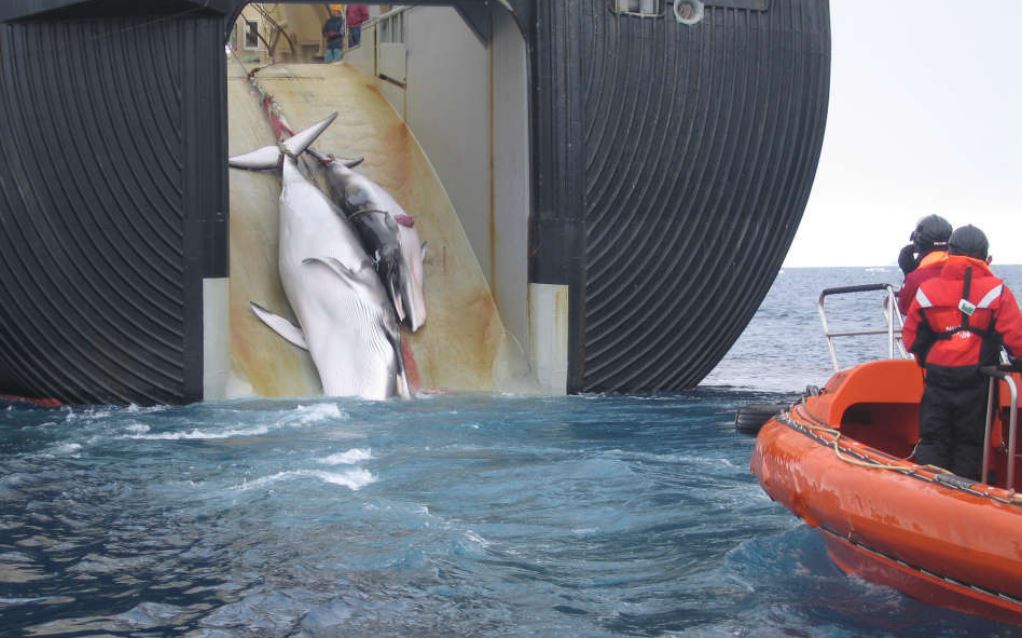Japan is preparing to restart commercial whaling next month for the first time in 30 years, after its controversial withdrawal from the International Whaling Commission (IWC).
On July 1, five ships from six whaling operators will set sail from Kushiro, on the northern Japanese island of Hokkaido.

It’s thought they plan to fish for beaked whales off the tip of Minamiboso, south of Tokyo, on Honshu island until August before heading to international waters to hunt minke whales until October.
Whale hunting
Commercial whaling has been banned since the IWC’s 1982 moratorium, placing a pause on whaling to allow species numbers to increase. Over 80 nations signed the agreement that came into being in 1986. However, several pro-whaling countries – namely Iceland, Norway, Russia, and Japan – have continued to exploit a loophole that allows whaling to be carried out under “scientific research”.
Japan, which set up its scientific whaling program one year after the ban came into force, has long argued that “biological sampling”, which can only be carried out by killing the whales, is essential for studying the whales’ age, health, and habits.
32,000 whales killed for research
Since the ban was introduced, it is estimated Japan has slaughtered over 32,000 whales.
Last year’s figures showed that in the December to February 2017/2018 season, Japan killed its yearly quota of 333 minke whales in Antarctic waters, 120 of which were pregnant, despite the fact Japan was banned from whaling in the Antarctic in 2014 after Australia took it to the United Nations’ International Court of Justice, accusing its research program of not being scientific in nature, and won. Japan, at the time, said it would abide by the UN’s ruling.
However, in July 2018, it announced its plan to seek approval from the IWC to resume whaling, saying it would agree to quotas set by the IWC and target only those species deemed to have sustainable numbers. After the IWC’s refusal, Japan announced in December its withdrawal from the global agreement and its intention to resume its commercial whaling industry.
Commercial whaling for cultural and economic reasons
Commercial whaling played an important role in post-Second World War Japan. In 1946, with a shattered economy and not enough food resources, US Major General Douglas MacArthur, who oversaw the Allied occupation of post-war Japan, commandeered two military tankers to become whaling vessels, introducing whale meat into school lunches, where a new generation of kids grew up eating it.
Reasons for resuming commercial whaling now are unclear, though Japan often cites defending cultural and traditional customs. However, these days, whale meat is not a regular part of the Japanese diet and the demand is low (the government pays around $50 million a year subsidizing whaling). Various polls over the last few years have found that though a larger percentage support the “research” program, very few people regularly eat whale meat, and those that do are of the older generation who remember eating it as children. Curiously, whale watching is on the rise in Japan too, among its own people, not just tourists.
Japan is not the only country to flout the moratorium
Denmark whaling takes the form of beaching and slaughtering long-finned pilot whales, a type of dolphin drive hunting during an annual pilot whale massacre at The Faroe Islands. It has been practised since about the time of the first Norse settlements on these North Atlantic islands and thus can be considered aboriginal whaling. It is mentioned in the Sheep Letter, a Faroese law from 1298, a supplement to the Norwegian Gulating law. It is regulated by the Faroese authorities. Around 800 long-finned pilot whales and some Atlantic white-sided dolphins are slaughtered annually, mainly during the summer. That’s really insane and totally graphic:
Norway objected to the ban on cultural grounds, and last year increased its hunting quota from 999 animals in 2017 to 1,278 in 2018.
Iceland left the moratorium in 1992, only to rejoin in 2002, then to resume commercial whaling in 2006. In 2018, it announced it would end the hunting of minke whales after a self-allocated quota of 262 whales in 2017 only yielded six whales. Earlier this year, it announced new quotas that will allow 209 fin whales and 217 minke whales to be hunted every year until 2025. However, this week the government withheld a hunting permit to the country’s only fin whaling company on the grounds that those previous quotas were based on unsound science.
This should really stop. There’s no research done there! It’s just butchery! For whales, meanwhile, the saga continues.











